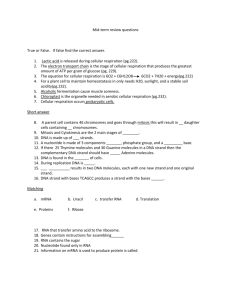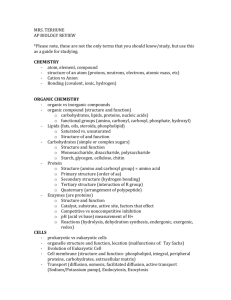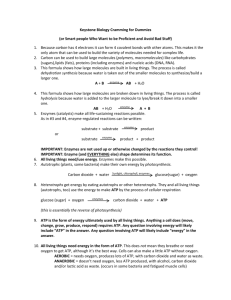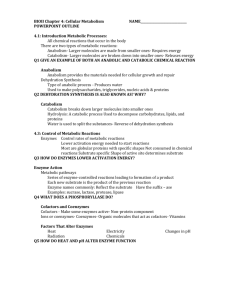Chapter 4: Cellular Metabolism
advertisement
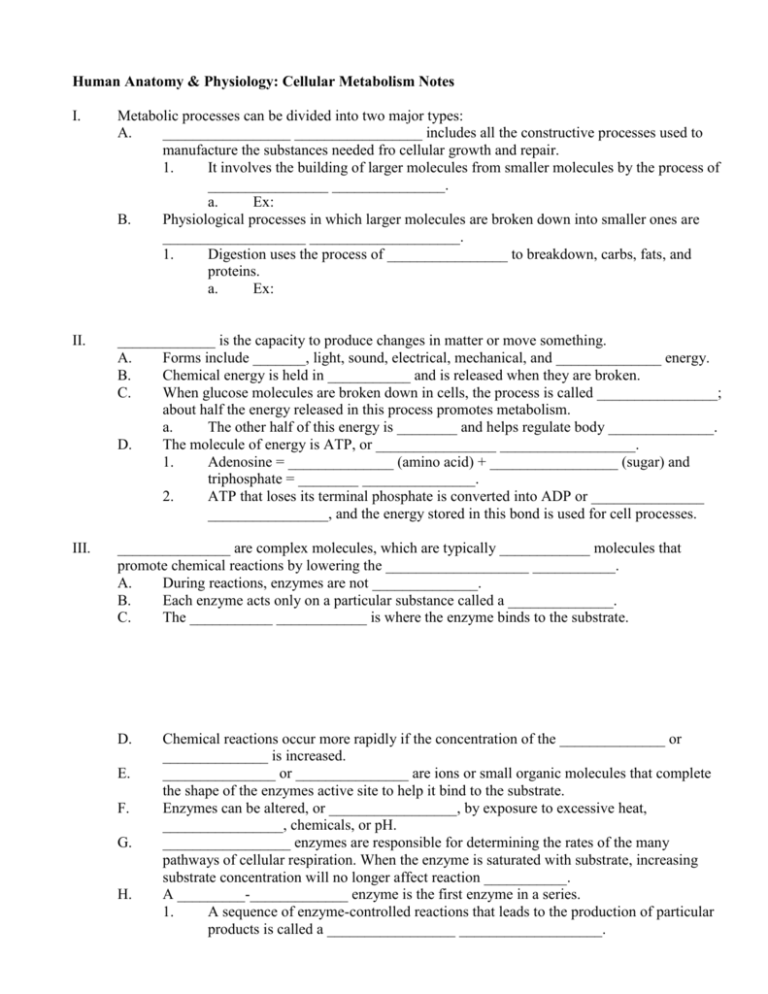
Human Anatomy & Physiology: Cellular Metabolism Notes I. Metabolic processes can be divided into two major types: A. _________________ _________________ includes all the constructive processes used to manufacture the substances needed fro cellular growth and repair. 1. It involves the building of larger molecules from smaller molecules by the process of ________________ _______________. a. Ex: B. Physiological processes in which larger molecules are broken down into smaller ones are ___________________ ____________________. 1. Digestion uses the process of ________________ to breakdown, carbs, fats, and proteins. a. Ex: II. _____________ is the capacity to produce changes in matter or move something. A. Forms include _______, light, sound, electrical, mechanical, and ______________ energy. B. Chemical energy is held in ___________ and is released when they are broken. C. When glucose molecules are broken down in cells, the process is called ________________; about half the energy released in this process promotes metabolism. a. The other half of this energy is ________ and helps regulate body ______________. D. The molecule of energy is ATP, or ________________ __________________. 1. Adenosine = ______________ (amino acid) + _________________ (sugar) and triphosphate = ________ _______________. 2. ATP that loses its terminal phosphate is converted into ADP or _______________ ________________, and the energy stored in this bond is used for cell processes. III. _______________ are complex molecules, which are typically ____________ molecules that promote chemical reactions by lowering the ___________________ ___________. A. During reactions, enzymes are not ______________. B. Each enzyme acts only on a particular substance called a ______________. C. The ___________ ____________ is where the enzyme binds to the substrate. D. E. F. G. H. Chemical reactions occur more rapidly if the concentration of the ______________ or ______________ is increased. _______________ or _______________ are ions or small organic molecules that complete the shape of the enzymes active site to help it bind to the substrate. Enzymes can be altered, or _________________, by exposure to excessive heat, ________________, chemicals, or pH. _________________ enzymes are responsible for determining the rates of the many pathways of cellular respiration. When the enzyme is saturated with substrate, increasing substrate concentration will no longer affect reaction ___________. A _________-_____________ enzyme is the first enzyme in a series. 1. A sequence of enzyme-controlled reactions that leads to the production of particular products is called a _________________ ___________________. IV. Cellular Respiration A. Anaerobic Respiration (Phase I) _______________________ 1. An enzyme controlled reaction in which a 6-carbon ______________ molecule is broken down into two 3-carbon ______________ _________ molecules. 2. Occurs in the __________________. 3. Takes place without ________________. 4. This process is also known as _________________. 5. The result: 2 _________, 2 ___________, 2 ____, and 2 _________________ B. Aerobic Respiration (Phase II) 1. Formation of Acetyl Coenzyme A a. 2 pyruvic acid molecules (from glycolysis) are broken down into 2 ____________ __________ molecules b. Occurs in the ________________ ___________ c. Result: 2 _________, 2 ____________, and 2 ______ 2. Citric Acid Cycle (___________ __________) a. a series of intermediate reactions that further breakdown Acetyl CoA b. Result: 2 _________, 4 __________, 6 __________, 2 __________, 6 _____ c. occurs in the ________________ ____________ 3. Electron Transport Chain/System a. Occurs in the __________ _______________ of the mitochondria b. ATP synthesis can occur as ______ move across the membrane, thus releasing ATP __________________. c. Allows the release of the large amount of chemical energy stored in _______ and _________. The energy released is stored in the form of ATP. ( __ ATP/ NADH vs __ ATP /FADH2) d. Result: 10 NADH = ___ ATP 2 FADH2 = ___ ATP + Total from ETC = ___ ATP Also: ___ O2, ___ H2O * ___ ATP are produced in liver, kidney, and heart cells, while only ___ ATP are produced in muscle cells and neurons. C. Total ATP produced: Glycolysis = ___ ATP (anaerobic); Krebs cycle = ___ ATP; ETC = ___ ATP Thus, 1 glucose molecule yields a total of ___ to ___ ATP during cellular respiration D. Lipids can be converted into Acetyl CoA and thus enter the Kreb’s Cycle by lipid _______________. 1. Fatty acid portions can undergo _________ _________________. 2. Fatty acid portions can be converted into ______________ ________________. 3. Glycerol can enter metabolic pathways leading into the Kreb’s Cycle. 4. Lipids contain more than _________ as much energy as carbs or proteins. E. When protein molecules are used as energy, they are hydrolyzed into __________ _______, which are in turn _______________. 1. The deaminated portions may be directly converted into Acetyl CoA, or may indirectly enter the Krebs cycle by being converted into ___________ or ____________. F. Anaerobic Respiration 1. __________________________ yields ___ ATP, CO2, ____________________ 2. __________________________ which produces _________________________ yields ___ ATP, pyruvic acid that is converted to _________________________ V. The Genetic Code A. Because enzymes control metabolic processes that enable cells to survive, cells must possess information for producing these _________________ _________________. 1. Proteins consist of ____ different amino acids joined in particular sequences. 2. Three bases in a DNA strand represent one kind of amino acid and are called a _________. a. _______________ (TAC) begins protein synthesis. b. ______ stops protein synthesis. c. This method of storing information for protein synthesis is the genetic _____. B. _______________________ _________ (DNA) possesses this information in the form of a _____________ _________ that instructs cells how to synthesize proteins. C. Genetic information in the form of DNA is ______________ and passes from parent to offspring. D. The portion of DNA that contains this genetic information for making proteins is called a ______ and instructs cells to create specific enzymes needed to control metabolic processes. VI. DNA A. The “backbone” of DNA is formed by alternating the sugar, __________________, and a phosphate group. B. The organic, __________________ bases project out from this backbone and bind weakly to bases on a second strand. 1. ______________ bonds only to thymine. 2. ______________ bonds only to guanine. 3. The particular _________________ of these base pairs encode the genetic information. C. The resulting structure of DNA resembles a twisted ladder or _____________ __________. D. Though DNA is located within _______________ in the nucleus, protein synthesis occurs in the cytoplasm. Thus, RNA functions to transfer the genetic code. VII. DNA Replication A. DNA molecules are replicated during ___________________. B. The DNA “____________” as bonds between base pair are broken. C. New _______________________ pair with the exposed bases and a new strand of complementary nucleotides is constructed along the _______ strands. D. The two new strands become incorporated into __________________ and are separated during mitosis. VIII. RNA A. _______________________ _______ are single-stranded molecules that contain the sugar, ___________. B. RNA, like DNA, contains four _____________________ bases. 1. ______________ bonds only to uracil. 2. ______________ bonds only to guanine. IX. Protein Synthesis (Chart 3.16 p.87) A. Transcription 1. The enzyme, _____ __________________, begins the process of unwinding DNA to form an exposed single strand. 2. ____________________ ______ is formed of nucleotides complementary to those arranged on the DNA strand. a. Ex: DNA strand: ATGCGTAAC RNA strand: b. The set of three nucleotides in mRNA that is complementary to the set on DNA is called a __________. 3. RNA synthase moves along the DNA strand until is reaches the terminal signal (stop triplet). Then, the enzyme releases the newly formed ________ and leaves the DNA. 4. mRNA moves through the nucleus into the __________________. B. C. __________________ - the process of using mRNA as templates in ribosomes to synthesize proteins. 1. __________________ RNA (tRNA) functions to position amino acids molecules in the proper location on an mRNA strand. a. Since there are 20 amino acids there must be ____ tRNA molecules. b. The three nucleotide sequences in tRNA are complementary to those in mRNA and are called ____________________. 2. The __________________ binds to mRNA near a codon at the beginning of a strand. 3. Next, a _______ molecule positions its amino acid and binds to the ribosome. 4. The amino acid becomes attached to a growing _____________________ chain. 5. Then, the tRNA releases the amino acid and returns to the ________________. 6. The process is repeated over and over as the ribosome moves along the __________. Amino acids are added to a developing protein _________ at time. The molecule begins to ________ into its unique shape, and upon completion, is released.

